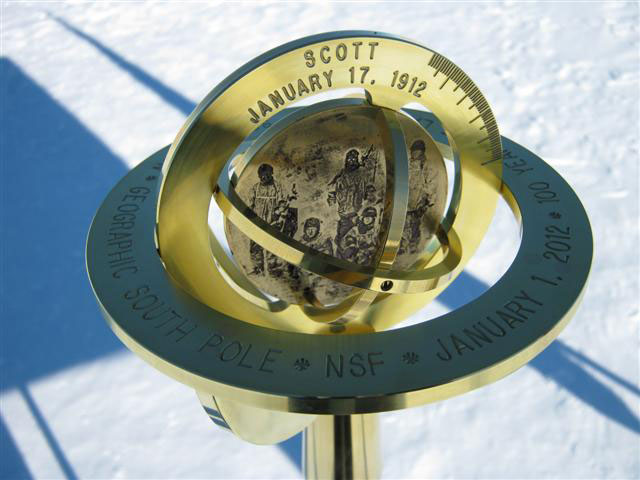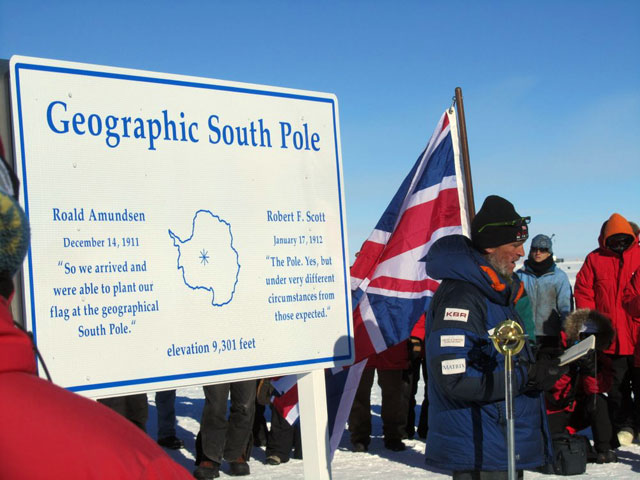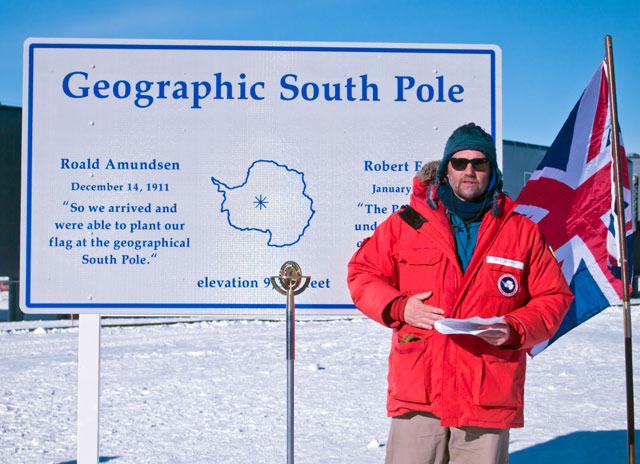|
A somber saluteAchievements of Scott honored at South Pole ceremonyPosted January 20, 2012
A large but somewhat somber crowd gathered outside of the South Pole Station It had been a bitter arrival for the weary polar explorers, as they discovered that their rival Roald Amundsen and his Norwegian party had beaten them to the geographic South Pole by more than a month. Dejected and already weak from the journey, Scott and his men all perished on the return journey to the coast. For Scott, the South Pole had turned out to be “an awful place.” But today it’s home to the Amundsen-Scott South Pole Station, an advanced research facility within the U.S. Antarctic Program (USAP) 
Photo Credit: Katie Hess/Antarctic Photo Library
The 2012 geographic South Pole marker depicts British Captain Robert Scott and his men at the South Pole on one side and Norwegian Roald Amundsen at the South Pole on the reverse side.
The centennial season of the so-called Race to the Pole between Amundsen and Scott has been a busy one for the station. Hundreds of visitors — many flying in on small aircraft operated by tourism companies, others doing it the hard way by ski and sled in imitation of the early explorers — have made the pilgrimage to the historic finish line. The Amundsen anniversary on Dec. 14, 2011, drew more than a hundred visitors, with a gathering at the ceremonial South Pole presided over by Norwegian Prime Minister Jens Stoltenberg The Scott centennial ceremony was a smaller affair, with about 75 visitors, in addition to the 200 or so U.S. support staff and scientists working at the South Pole Station. The event was coordinated between the station management and Antarctic Logistics & Expeditions (ALE) Tim Hewette, ALE camp manager, opened the ceremony before turning it over to Bill Coughran, the South Pole area director. Coughran noted that Scott’s Antarctic explorations weren’t limited to discovering new territories, but also expanding scientific knowledge. “Even in their final hours, he and his men refused to abandon samples of rocks and fossils they’d collected, even though lightening their burden might have given them a better chance at survival,” he told the crowd gathered at the geographic South Pole. “The U.S. Antarctic Program and all scientists who work on this continent owe a great deal to that scientific legacy,” he added. “That spirit of scientific curiosity in the face of adversity is evident here today in the world-class research that NSF supports and facilitates at the South Pole to investigate scientific questions on that cosmic scale.” Julie Palais, the NSF science representative, then made a short speech for the commemoration. Later, she reflected on the moment. “It was fantastic to be at the Pole for this anniversary. I really felt that I was part of Antarctic history to be at the Pole for this event,” said Palais, glaciology program manager in NSF’s Office of Polar Programs who has made 25 trips to the Ice. Palais was followed by Lt. Col. Henry Worsley of the Royal British Legion. Henry Worsley is a distant relative of Commander Frank Worsley, a key member of Ernest Shackleton’s Imperial Trans-Antarctic Expedition of 1914–1916. Like his famous ancestor, Henry Worsley is also a polar explorer. During the 2008-09 season, he took part in the Shackleton Centenary Expedition This year, Henry Worsley led one of two British military teams that were recreating the Race to the South Pole between Scott and Amundsen “It was a real treat to be here for both centennials,” said South Pole Station Fire Chief Andre Fleuette on Dec. 18 (local time). “I think the one yesterday — considering that it was as much a memorial service as a celebration — was much more heartfelt than the Norwegian ceremony.” Fleuette said it was particularly poignant to hear Worsley — his face scabbed and peeling from frostbite — read parts of Scott’s diary in praise of his companions. A science team with the British Antarctic Survey The tourism season at the South Pole, which has grown in recent years despite the global recession, generally ends by late January. The station will begin winter operations on Feb. 15, leaving it isolated until later October or early November.
|



For USAP Participants |
For The Public |
For Researchers and EducatorsContact UsU.S. National Science FoundationOffice of Polar Programs Geosciences Directorate 2415 Eisenhower Avenue, Suite W7100 Alexandria, VA 22314 Sign up for the NSF Office of Polar Programs newsletter and events. Feedback Form |




